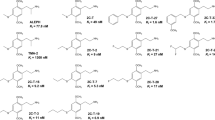Abstract
Ergometrine (2.5–80 mg/kg IP) induced head twitches in mice. Pretreatment with cyproheptadine (1.5 and 3 mg/kg), methysergide (5 and 10 mg/kg) and (−)-propranolol (2.5 and 5 mg/kg) significantly decreased the number of head twitches induced by ergometrine. Pretreatment with p-chlorophenylalanine (100 mg/kg/day×4 days) and clomipramine (5 and 10 mg/kg) significantly decreased the number of head twitches induced by fenfluramine (10 mg/kg) and p-chloramphetamine (5 mg/kg) but had no significant effect on the number of head twitches induced by ergometrine. The results indicate that ergometrine induces head twitches in mice by directly stimulating central 5-hydroxytryptamine receptors.
Similar content being viewed by others
References
Balsara JJ, Gada VP, Nandal NV, Chandorkar AG (1984) Psychopharmacological investigation of the monoamine oxidase inhibitory activity of molindone, a dihydroindolone neuroleptic. J Pharm Pharmacol 36:608–613
Brazeau P (1970) Drugs affecting uterine motility. In: Goodman LS, Gilman A (eds) The pharmacological basis of therapeutics. The Macmillan Company, New York, pp 893–907
Buus-Lassen J (1974) The effect of p-chloroamphetamine on motility in rats after inhibition of monoamine synthesis, storage, uptake and receptor interaction. Psychopharmacologia 34:243–254
Connell DJ, Middlemiss DN, Stone MA (1980) Further evidence for an interaction of propranolol with the central 5-hydroxytryptamine (5-HT) receptor. Br J Pharmacol 68:173–174
Corne SJ, Pickering RW (1967) A possible correlation between drug-induced hallucinations in man and a behavioural response in mice. Psychopharmacologia 11:65–78
Corne SJ, Pickering RW, Warner BT (1963) A method for assessing the effects of drugs on the central actions of 5-hydroxytryptamine. Br J Pharmacol 20:106–120
Fuller RW (1980) Mechanism by which uptake inhibitors antagonize p-chloroamphetamine-induced depletion of brain serotonin. Neurochem Res. 5:241–245
Garattini S, Caccia S, Mennini T, Samanin R, Consolo S, Ladinsky H (1979) Biochemical pharmacology of the anorectic drug fenfluramine: A review. Curr Med Res Opin (Suppl) 6:15–27
Goodwin GM, Green AR (1985) A behavioural and biochemical study in mice and rats of putative selective agonists and antagonists for 5-HT1 and 5-HT2 receptors. Br J Pharmacol 84:743–753
Green AR, Hall JE, Rees AR (1981) A behavioural and biochemical study in rats of 5-hydroxytryptamine receptor agonists and antagonists, with observations on structure-activity requirements for the agonists. Br J Pharmacol 73:703–719
Green AR, Johnson P, Nimgaonkar VL (1983a) Interactions of β-adrenoceptor agonists and antagonists with the 5-hydroxytryptamine2 (5-HT2) receptor. Neuropharmacology 22:657–660
Green AR, O'Shaughnessy K, Hammond M, Schächter M, Grahame-Smith DG (1983b) Inhibition of 5-hydroxytryptamine-mediated behaviour by the putative 5-HT2 antagonist pirenperone. Neuropharmacology 22:573–578
Joshi VV, Gada VP, Balsara JJ, Chandorkar AG (1983) Fenfluramine-induced head-twitch response in mice and its modification by certain drugs influencing the central 5-hydroxytryptamine function. Ind J Physiol Pharmacol 27:249–252
Koe BK, Weissman A (1966) p-Chlorophenylalanine: a specific depletor of brain serotonin. J Pharmacol Exp Ther 154:499–516
Marsden CA, Conti J, Strope E, Curzon G, Adams RN (1979) Monitoring 5-hydroxytryptamine release in the brain of the freely moving unanaesthetized rat using in vivo voltammetry. Brain Res. 171:85–99
Middlemiss DN, Blakeborough L, Leather SR (1977) Direct evidence for an interaction of β-adrenergic blockers with the 5-HT receptor. Nature 267:289–290
Nahorski SR, Willcocks AL (1983) Interactions of β-adrenoceptor antagonists with 5-hydroxytryptamine receptor subtypes in rat cerebral cortex. Br J Pharmacol 78:107
Nakamura M, Fukushima H (1978a) Effect of 5,6-dihydroxytryptamine on the head twitches induced by 5-HTP, 5-HT, mescaline and fludiazepam in mice. J Pharm Pharmacol 30:56–58
Nakamura M, Fukushima H (1978b) Effects of reserpine, parachlorophenylalanine, 5,6-dihydroxytryptamine and fludiazepam on the head twitches induced by 5-hydroxytryptamine or 5-methoxytryptamine in mice. J Pharm Pharmacol 30:254–256
Orikasa S, Sakurada S, Kisara K (1980) Head-twitch response induced by tyramine. Psychopharmacology 67:53–59
Peroutka SJ, Lebovitz RM, Snyder SH (1981) Two distinct central serotonin receptors with different physiological functions. Science 212:827–829
Peroutka SJ, Snyder SH (1979) Multiple serotonin receptors: differential binding of (3H)5-hydroxytryptamine, (3H)lysergic acid diethylamide and (3H)spiroperidol. Mol Pharmacol 16:687–699
Ross SB, Renyi AL (1975) Tricyclic antidepressant agents. I. Comparison of the inhibition of the uptake of 3H-noradrenaline and 14C-5-hydroxytryptamine in slices and crude synaptosome preparations of the midbrain-hypothalamus region of the rat brain. Acta Pharmacol Toxicol (Kbh) 36:382–394
Singleton C, Marsden CA (1981) Circadian variation in the head twitch response produced by 5-methoxy-N1,N1-dimethyltryptamine and p-chloroamphetamine in the mouse. Psychopharmacology 74:173–176
Trulson ME, Jacobs BL (1976) Behavioral evidence for the rapid release of CNS serotonin by PCA and fenfluramine. Eur J Pharmacol 36:149–154
Vetulani J, Bednarczyk B, Reichenberg K, Rokosz A (1980) Head-twitches induced by LSD and quipazine: similarities and differences. Neuropharmacology 19:155–158
Weinstock M, Weiss C, Gitter S (1977) Blockade of 5-hydroxytryptamine receptors in the central nervous system by β-adrenoceptor antagonists. Neuropharmacology 16:273–276
Yap CY, Taylor DA (1983) Involvement of 5-HT2 receptors in the wet-dog shake behaviour induced by 5-hydroxytryptophan in the rat. Neuropharmacology 22:801–804
Author information
Authors and Affiliations
Additional information
Offprint requests to: J.J. Balsara
Rights and permissions
About this article
Cite this article
Balsara, J.J., Bapat, T.R., Nandal, N.V. et al. Head-twitch response induced by ergometrine in mice: Behavioural evidence for direct stimulation of central 5-hydroxytryptamine receptors by ergometrine. Psychopharmacology 88, 275–278 (1986). https://doi.org/10.1007/BF00180824
Received:
Revised:
Issue Date:
DOI: https://doi.org/10.1007/BF00180824




